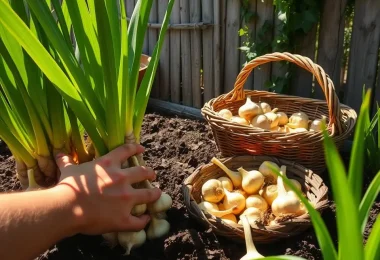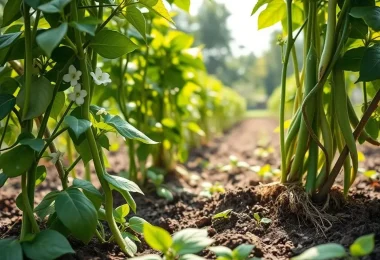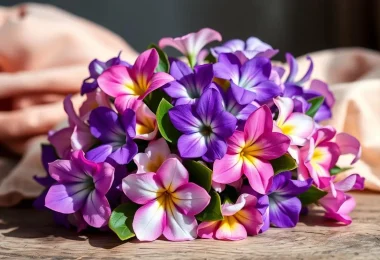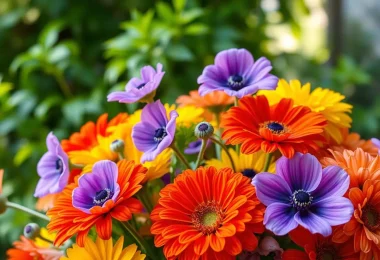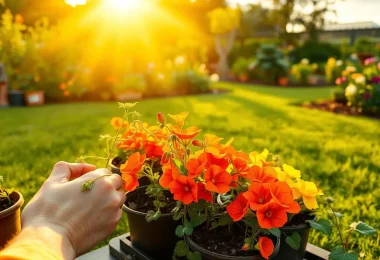Verbena is a stunning group of flowering plants that can brighten up any garden. Their delicate, umbrella-shaped blooms and trailing habit make them perfect for borders, containers, and groundcover. This guide will help you grow vibrant, long-lasting verbena plants in your garden, whether you’re experienced or new to gardening.
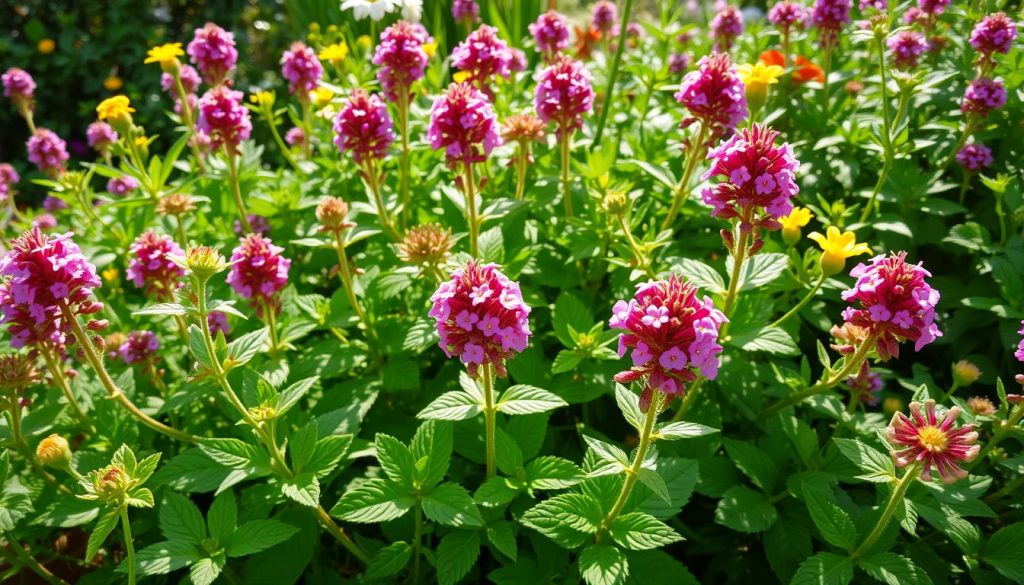
Key Takeaways
- Verbena is a versatile, low-maintenance flowering plant that can thrive in a variety of garden settings.
- Selecting the right verbena variety, whether annual or perennial, is crucial for achieving the desired growth habits and bloom characteristics.
- Providing the ideal planting conditions, including well-draining soil and ample sunlight, is essential for verbena’s success.
- Proper care, such as regular watering, balanced fertilisation, and strategic pruning, can help verbena plants reach their full potential.
- Verbena can be propagated through seed sowing, division, or cuttings, allowing gardeners to expand their verbena collection.
related : Discover the Beauty of Viburnum for Your Garden
Introduction to Verbena: A Colourful and Hardy Bloomer
Verbena is a stunning group of flowering plants known for their vibrant colours and hardiness. These plants are loved for their bright blooms and easy care. They come in a wide range of colours, from fiery reds and oranges to soft pastels.
Verbena plants are incredibly tough. They can handle hot, dry weather and even light frosts. This makes them great for borders, containers, and ground covers. They can grow in different ways, adding beauty to hanging baskets or garden beds.
Verbena plants are also very versatile. They do well in full sun to partial shade and can grow in many soil types. This makes them perfect for adding colour and texture to any outdoor space, no matter the soil.
Whether you prefer the bold, trailing verbena varieties or the more compact, upright ones, there’s something for everyone. This genus offers endless possibilities for creating stunning displays that enhance any outdoor area.
Choosing the Right Verbena Variety for Your Garden
When picking verbena for your garden, think about the many verbena varieties out there. You’ll find both annual verbena and perennial verbena. Knowing what each type needs helps you choose the best verbena for your garden.
Annual Verbena Varieties
Annual verbena varieties are loved for their bright colours and long-lasting flowers. They grow well in hanging baskets and window boxes. These plants bloom from spring to frost, adding colour all season.
Perennial Verbena Varieties
Perennial verbena varieties last longer in your garden. They can handle cold winters and come back year after year. These plants are great for groundcover and adding colour to rock gardens and borders.
When choosing verbena, think about your climate, garden size, and what you like. The right verbena varieties will make your garden beautiful and lively all season.
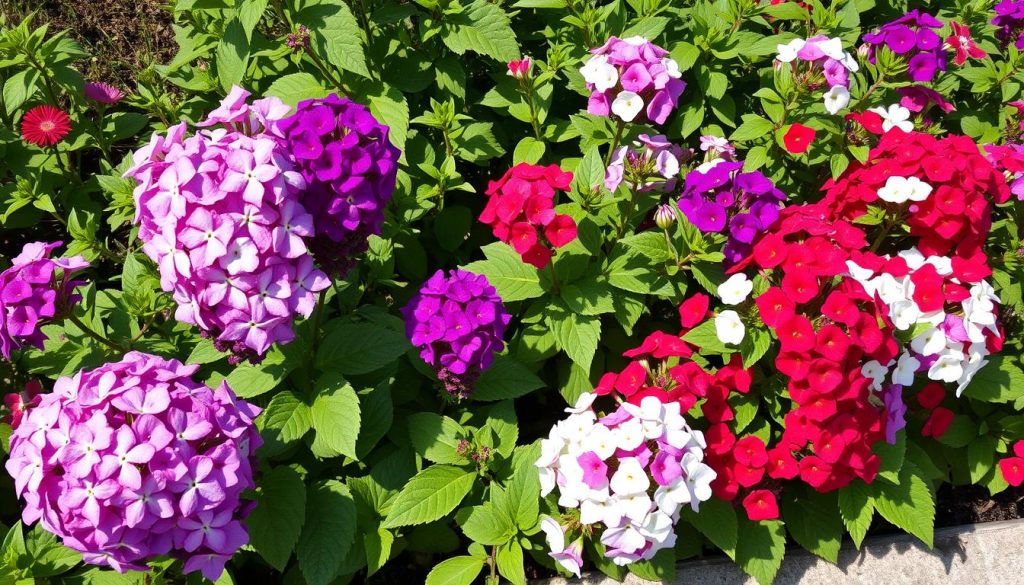
| Annual Verbena | Perennial Verbena |
|---|---|
| Bloom from spring to frost | Hardier, return year after year |
| Trailing habit, great for hanging baskets | Ideal for groundcover and borders |
| Vibrant, long-lasting colours | Larger flower clusters |
Preparing the Ideal Planting Site for Verbena
To make sure your verbena plants do well, you need to prepare the right spot. Verbena likes soil that drains well and is rich in nutrients. It also needs full sun. Knowing what verbena soil requirements and verbena growing conditions are will help you create the best verbena planting site for your garden.
When picking a spot for your verbena, look for a place that gets at least 6 hours of direct sunlight a day. Verbena loves full sun, so avoid shady spots. Also, make sure the soil drains well and is slightly acidic, with a pH between 6.0 and 7.0.
- Amend the soil with organic matter, such as compost or well-rotted manure, to improve drainage and nutrient content.
- Avoid heavy, clay-based soils, as they can lead to water-logging and root rot.
- If your soil is particularly poor, consider creating a raised garden bed or planter to provide the ideal growing medium for your verbena.
After picking the perfect verbena planting site, prepare the area well. Dig the soil to a depth of 8-10 inches, removing weeds or debris. This helps the verbena roots grow well and get the nutrients and moisture they need.
“Verbena is a versatile plant that can thrive in a wide range of growing conditions, but preparing the ideal planting site is the key to success.”
By following these tips, you’ll make a great place for your verbena plants to grow. They will give you beautiful, long-lasting flowers all season.
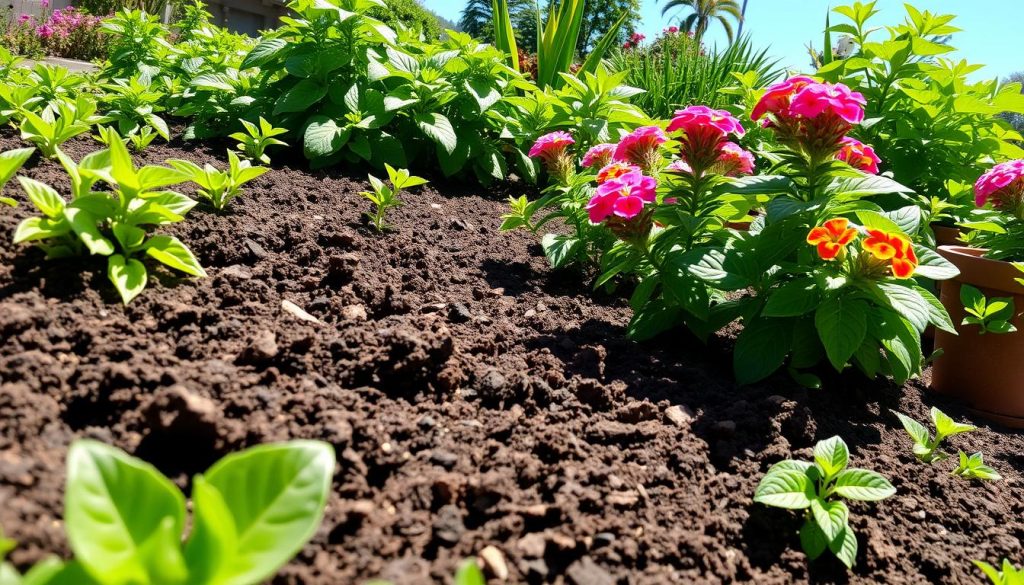
Planting Verbena: Step-by-Step Instructions
Starting verbena from seed or transplanting seedlings is rewarding. It brings vibrant colour to your garden. Whether you’re experienced or new, these steps will help you plant verbena successfully.
Sowing Seeds Indoors
Sow verbena seeds indoors 6-8 weeks before the last frost. Use a well-drained mix, covering the seeds lightly. Keep the soil moist and sunny or use a grow light.
When seedlings have true leaves, move them to individual pots. This helps their roots grow well.
Transplanting Seedlings Outdoors
Wait until frost is gone to transplant verbena seedlings outside. Pick a sunny spot with good drainage. Loosen the soil and add compost for better growth.
Plant seedlings at the same depth as before. Space them 12-18 inches apart, depending on the variety.
Water the seedlings well and keep the soil moist. With proper care, your verbena will bloom beautifully all season.
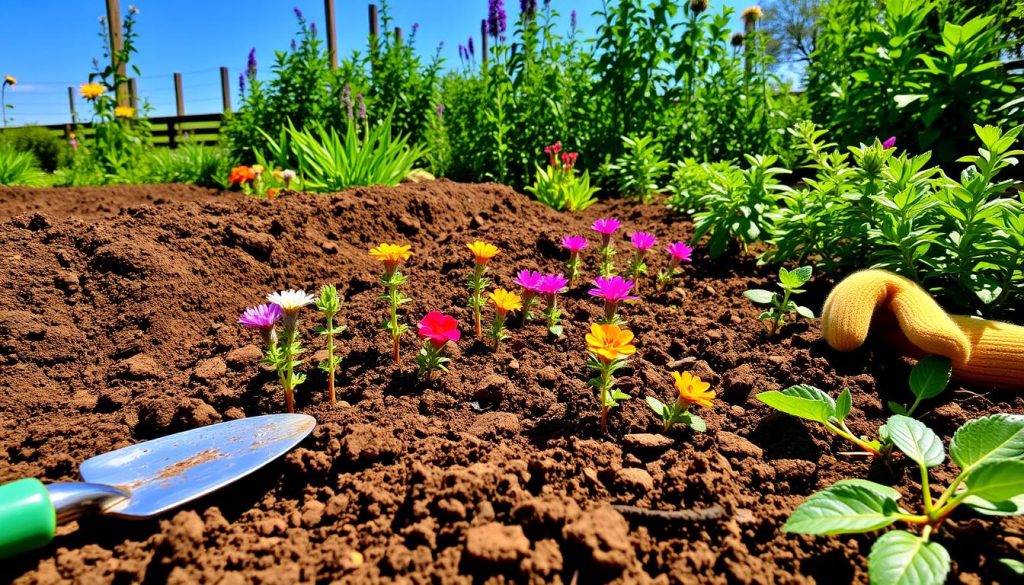
Caring for Verbena Plants
Proper care is key for verbena plants to thrive. They need the right amount of water and nutrients. This section will guide you on how to keep your verbena care plants healthy and blooming.
Watering Requirements
Verbena plants need moderate watering. They prefer soil that drains well. Water them when the top inch of soil feels dry.
Keep the soil moist but not too wet. Over-watering can cause root rot. In hot, dry weather, you might need to water more often to keep your plants looking their best.
Fertilising for Optimal Growth
For lush growth and lots of verbena flowers, fertilising is important. Use a balanced, water-soluble fertiliser every two to three weeks when they’re growing. Or, apply a slow-release fertiliser at the start of the season.
This gives your plants a steady flow of nutrients. It helps them grow well throughout the season.
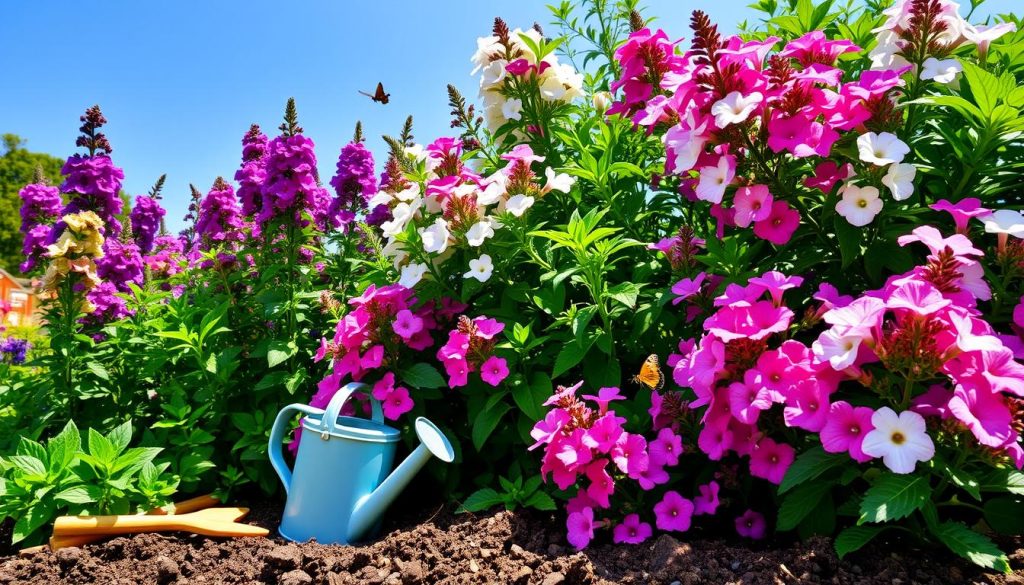
“Proper care and attention is the key to growing thriving verbena plants that will reward you with a vibrant display of colour all season long.”
Pruning Verbena for Healthy Blooms
To keep your verbena garden vibrant, you need to prune and deadhead regularly. These steps help your verbena plants bloom continuously. They also keep your garden looking neat and attractive all season.
Pruning Verbena Plants
Start by cutting off any dead, damaged, or stray stems with sharp secateurs. Cut just above a healthy leaf or bud for a neat shape. Regular trimming helps your verbena focus on making more flowers, not just growing.
Deadheading Verbena Flowers
Deadheading is key to keeping your verbena looking great. When the florets start to fade, snip them off with your fingers or clean scissors. This stops the plant from wasting energy on seeds and helps it make more flowers.
Try to deadhead your verbena at least once a week when it’s blooming the most. This way, you’ll have more colourful flowers all summer.
| Pruning Frequency | Deadheading Frequency |
|---|---|
| Prune every 4-6 weeks Remove dead, damaged or wayward stems Cut just above healthy leaves or buds | Deadhead weekly during peak bloom Remove spent flower heads Encourage continuous flowering |
Regular pruning and deadheading will make your verbena garden lush and vibrant. It will be a joy to look at and impress your garden visitors all season.
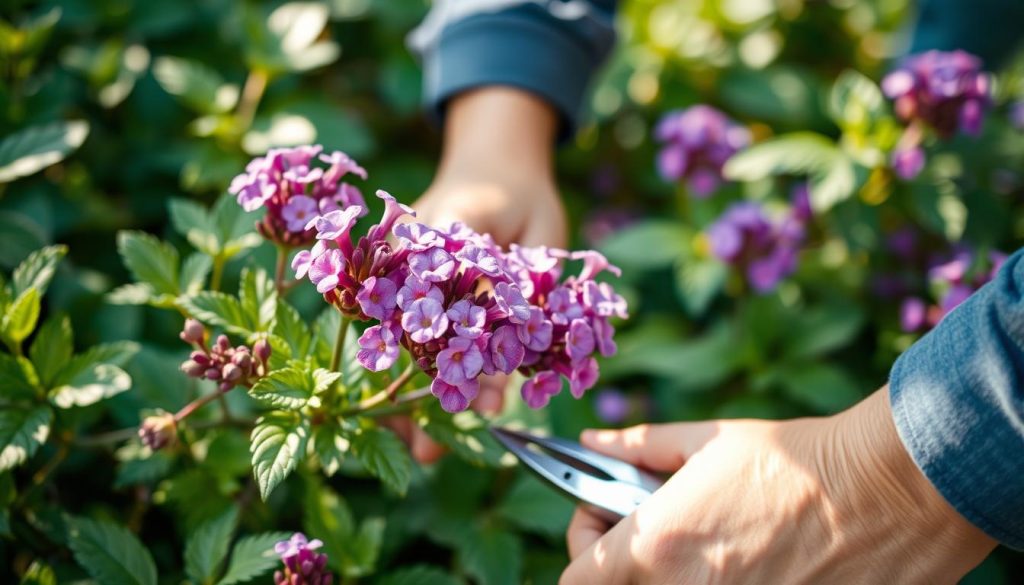
Verbena Pests and Diseases
Verbena plants are usually tough and resilient. But, they can still get sick or infested with pests. It’s important to spot and fix these problems quickly to keep your verbena looking great.
Common Verbena Pests
- Spider mites: These tiny bugs can make verbena plants look discoloured and stunted. Keeping the leaves clean and misting them regularly can help keep them away.
- Aphids: These insects suck the sap from verbena’s new growth. A blast of water or insecticidal soap can get rid of them.
- Thrips: These small insects can make verbena leaves and flowers look silvered and distorted. Using insecticidal sprays or neem oil can control them.
Common Verbena Diseases
- Powdery mildew: This fungus makes verbena leaves and stems look white and powdery. Better air flow and a fungicide can help fight it.
- Rust: This disease shows up as rust-coloured spots on leaves. Cutting off the affected parts and using a fungicide is the best course of action.
- Botrytis blight: Also known as grey mould, it causes rot and discolouration. Good air flow and avoiding water on the leaves can prevent it.
| Pest/Disease | Symptoms | Treatment |
|---|---|---|
| Spider mites | Discoloration, stunted growth | Misting, clean foliage |
| Aphids | Congregate on new growth | Water jet, insecticidal soap |
| Thrips | Silvering, distortion of leaves and flowers | Insecticidal sprays, neem oil |
| Powdery mildew | White, powdery coating on leaves and stems | Improve air circulation, apply fungicide |
| Rust | Rust-coloured spots on foliage | Remove affected leaves, apply fungicide |
| Botrytis blight | Rot and discolouration of flowers and leaves | Improve air flow, avoid overhead watering |
Acting fast to deal with verbena pests and verbena diseases is key. This way, your verbena pest control and verbena disease management will be effective. Your plants will stay healthy and vibrant.
Overwintering Verbena Plants
As winter gets closer, gardeners with a love for verbena must think about how to care for these plants. They need a bit more attention to survive the cold. But, the joy of seeing their colours in spring makes it all worth it.
Preparing Verbena for Winter
To keep your verbena safe from harsh weather, follow these tips:
- Prune verbena plants back by about a third before the first frost. This makes them smaller and protects the leaves.
- Mulch the base of the plants with a thick layer of organic material, like straw or leaves. It keeps the roots warm and stops them from freezing.
- If growing verbena in containers, move them to a safe place. A greenhouse or cold frame can protect them from bad weather.
In very cold places, you might need to do more to ensure your verbena plants survive. You could use a frost blanket or hoop house.
“Protecting verbena during the winter months is essential for enjoying their vibrant blooms year after year.”
By using these easy verbena overwintering methods, you can take good care of your verbena in winter. You’ll be excited to see their colours again in the future.
Propagating Verbena: Divisions and Cuttings
Expanding your verbena garden or sharing these vibrant plants is easy. You can use verbena propagation, verbena division, and verbena cuttings. These methods let you grow more of this colourful bloomer with little effort.
Dividing Verbena Plants
Dividing mature verbena plants is simple and effective. In early spring or autumn, lift the plant from the soil. Gently tease apart the root system and replant the divisions in well-draining soil.
Water thoroughly and watch the new plants grow. They will establish themselves over time.
Taking Verbena Cuttings
For verbena propagation via cuttings, pick healthy, non-flowering stems. Cut them just below a leaf node. Remove the lower leaves and dip the cut end in rooting hormone.
Plant the cuttings in a well-draining potting mix. Keep the soil moist and provide bright, indirect light. Roots should develop in 4-6 weeks.
“Verbena is a versatile plant that can be easily propagated through division or cuttings, allowing you to expand your garden with ease.”
Whether you divide your existing verbena plants or take cuttings, these methods are great. They help you grow your collection and share the joy of these colourful, low-maintenance blooms.
Companion Planting with Verbena
Verbena is a versatile plant that makes an excellent companion in the garden. Pairing verbena with the right plants creates a stunning display. Let’s explore some of the best verbena companion plants for your garden.
Complementary Colours and Textures
Verbena’s vibrant blooms in shades of pink, purple, and white look great with plants of contrasting hues and textures. Plant verbena alongside zinnia, marigold, or petunia for a captivating colour palette. The trailing habit of verbena also complements the upright growth of lavender, sage, or rosemary.
Attracting Beneficial Insects
Verbena attracts bees, butterflies, and hummingbirds to the garden. Pair verbena with sunflowers, cosmos, or lantana to draw in more beneficial insects. These plants offer nectar-rich flowers that pollinators love.
| Verbena Companion Plants | Complementary Traits |
|---|---|
| Zinnia, Marigold, Petunia | Vibrant Colours |
| Lavender, Sage, Rosemary | Contrasting Textures |
| Sunflower, Cosmos, Lantana | Attract Pollinators |
By choosing verbena companion plants that complement its growth and bloom, you can create a stunning garden. This garden will thrive throughout the season.
Creative Ways to Display Verbena
Verbena is a joy to have in any garden. It offers many ways to show off its bright colours. You can use it in containers or hanging baskets to make your garden a stunning place.
Container Gardening with Verbena
Verbena loves containers, making it great for small spaces. Pick a potting mix that drains well and a big enough container. Plants like Verbena bonariensis and Verbena x hybrida look amazing, spilling over the edges.
Verbena in Hanging Baskets
Verbena looks fantastic in hanging baskets. Its trailing habit makes it perfect for hanging baskets. Mix it with plants like ivy or petunias for a beautiful look.
Verbena garden design is all about creativity. You can use it in containers, baskets, or as part of a bigger garden. Its hardiness and beauty make it a great choice for any outdoor space.
Verbena in Cottage Gardens and Borders
Verbena is great for cottage gardens and borders because it’s low-growing and blooms a lot. Its bright colours and trailing growth fit well with the informal look of these gardens. It looks good as edging, spilling over raised beds, or with flowers like lavender and marigolds.
In garden borders, verbena brings colour and softens the look. There are many types of verbena, from low-growing to tall, offering lots of design options. It pairs well with peonies, English roses, and ornamental grasses for a classic look.
Planting verbena in big drifts or masses makes a beautiful display. Its trailing habit is perfect for spilling over raised beds or walls. Verbena is hardy and blooms for a long time, making it a great choice for any garden.
FAQ
What is the best way to grow verbena plants?
To grow verbena well, pick a spot with good drainage and rich soil. It should get full sun. Start by adding organic matter to the soil. Plant seedlings or seeds in spring and water them often.
Prune and deadhead the plants to keep them blooming.
How do I care for my verbena plants?
Verbena needs regular watering, especially when it’s dry. Use a balanced fertiliser to help it grow strong and flower well. Prune and deadhead to keep the plant looking neat and blooming.
What are the different types of verbena available?
Verbena comes in annual and perennial types. Annuals are smaller, while perennials can spread or grow upright. ‘Homestead Purple’, ‘Lanai Violet’, and ‘Bicolor’ are some popular types.
How can I protect my verbena plants during the winter?
In cold areas, verbena needs extra care in winter. Mulch the soil to keep the roots warm. You can also cover plants with a frost blanket or move potted ones to a safe spot.
Can I propagate my verbena plants?
Yes, you can propagate verbena by division or cuttings. Division is best in spring for new plants. Cuttings can be rooted in the growing season to make new plants.
What are some good companion plants to grow with verbena?
Verbena looks great with petunias, marigolds, zinnias, and lantana. These plants together make a colourful and beautiful garden display.
How can I use verbena in my garden design?
Verbena is very versatile for garden design. It’s perfect for containers, hanging baskets, and as a groundcover. It also fits well in cottage gardens, borders, and other traditional layouts.



